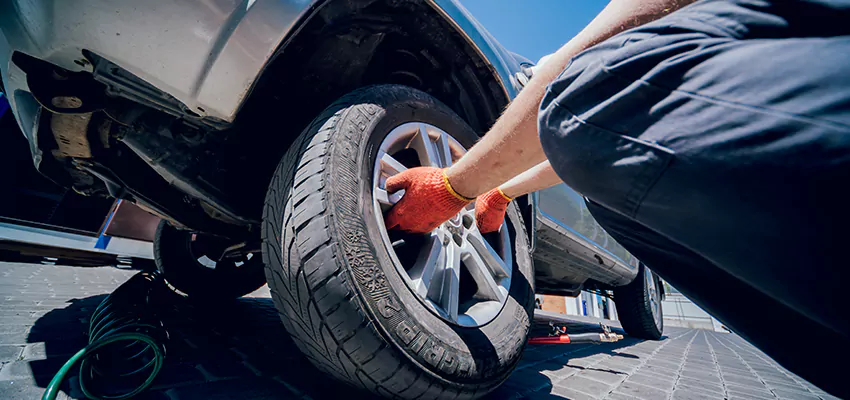Dealing with a flat tire can be a major inconvenience, especially if you’re traveling to work or rushing to an appointment. In Buffalo, where road conditions can be challenging due to weather and infrastructure, flat tires happen more often than you’d like. Understanding what causes flat tires and how to handle them can save you time and stress.
This guide will discuss why flat tires occur, how to fix them yourself, and what to do if you lack the necessary tools or skills. Learn to take control of your travels by effectively preventing and managing flat tire situations in Buffalo.
Understanding Why Flat Tires Happen
Flat tires are a common headache for Buffalo drivers, and knowing why they occur can give you a head start in preventing them. One of the biggest culprits is potholes that dot the city’s roads. These deep holes can damage tires, leading to sudden flats or slow leaks. Debris, such as nails, glass, or sharp stones, can also puncture tires, especially on less-traveled routes where obstacles might be harder to see.
Weather plays a significant role in tire health as well. Seasonal changes, mainly the harsh Buffalo winters, can weaken your tires. Cold weather causes tires to contract, leading to a drop in tire pressure. Under-inflated tires wear out quicker and increase the risk of a flat. In contrast, hot summer days lead to tire expansion, stressing them out even further.
Regular tire maintenance is a crucial preventative measure. By routinely checking tire pressure and inspecting for signs of wear or objects lodged in the tread, you can catch potential issues before they become full-blown problems. Proper tire maintenance ensures your tires stay in good shape, helping you avoid unexpected flat tires during your travels.
Step-by-Step Guide to Changing a Flat Tire
If you have a flat tire, knowing how to change it is essential. The process requires a few simple tools that should always be kept in your car—a jack, a lug wrench, and a spare tire. These tools help lift the car, remove the damaged tire, and replace it with your spare.
Here’s an essential guide to changing a flat tire:
1. Find a Safe Spot: Pull over to a safe and flat area, away from traffic.
2. Turn on Hazards: Turn on your hazard lights to alert other drivers.
3. Loosen the Lug Nuts: Use the lug wrench to loosen the lug nuts slightly while the vehicle is still on the ground.
4. Lift the Car: Position the jack under the car’s frame and lift the car until the flat tire is off the ground.
5. Remove the Flat Tire: Remove the loosened lug nuts and remove the flat tire.
6. Mount the Spare Tire: Place the spare tire onto the hub and hand-tighten the lug nuts.
7. Lower the Car: Use the jack to lower the car back to the ground.
8. Tighten the Lug Nuts: Once fully lowered, tighten the lug nuts securely in a crisscross pattern.
Safety is vital, particularly when changing a tire on busy streets or highways. Always work on the side away from traffic, stand clear of moving vehicles, and wear a reflective vest if you have one. A flat tire doesn’t have to ruin your day—with the right preparation and knowledge, you can change it quickly and get back on the road safely.
Preventing Flat Tires Before They Happen
Taking steps to prevent flat tires ensures smoother and safer journeys. One of the simplest practices is checking your tire pressure regularly. Tires with the right pressure last longer and perform better. Use a tire gauge to monitor pressure, especially after temperature changes, influencing tire inflation.
Examine your tire tread depth often. Bald tires are more at risk for punctures and poor handling. You can do this using a penny test: insert a penny into the tread with Lincoln’s head upside down. Your tread is worn out if you see the top of his head.
Be vigilant for early signs of tire issues like bulges on the tire surface or cracks in the sidewall. These are red flags for potential tire failure. Fixing problems early can reduce the chance of experiencing a flat tire while driving.
Having a tire repair kit in your vehicle is beneficial. This kit includes tools to temporarily patch up minor punctures, allowing you time to drive to the nearest service center. Using this kit empowers you to manage minor issues independently, enhancing your overall safety on the road.
What to Do If You Can’t Fix a Flat Tire Yourself
Sometimes, handling a flat tire on your own can be challenging. In such cases, knowing what to do is crucial. First, pull over to a safe location, like the shoulder of the road, and turn on your hazard lights. These lights alert other drivers to your situation, helping to keep you safe.
Engage the emergency brake to secure your vehicle. This prevents the car from rolling, especially on an incline. Stay inside the vehicle with the seatbelt fastened until help arrives.
Certain situations require professional help, such as when you don’t have the right tools when it’s too dangerous to change the tire, or if it has extensive damage. When reaching out for roadside assistance, explain your location clearly and describe the problem in detail.
Good communication with the service provider is important. Ask for an estimated wait time and share any safety concerns. Having a clear plan will make the situation more manageable and less stressful.
Conclusion
Flat tires can disrupt your daily routine, but understanding how to deal with them effectively is vital. From being aware of what causes flats to confidently changing a tire and knowing when to seek help, these are all crucial skills for any driver. Prevention, preparation, and informed action can smooth your travels in and around Buffalo.
For times when you need towing services in Buffalo, Schoemann’s Road Service, Inc. is ready to assist. Whether it’s a flat tire or another roadside emergency, our expert team ensures you’re back on the road swiftly and safely. Reach out when you need reliable roadside assistance in Buffalo.


